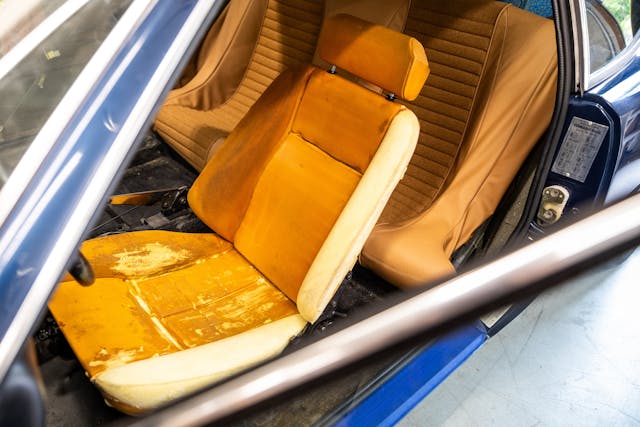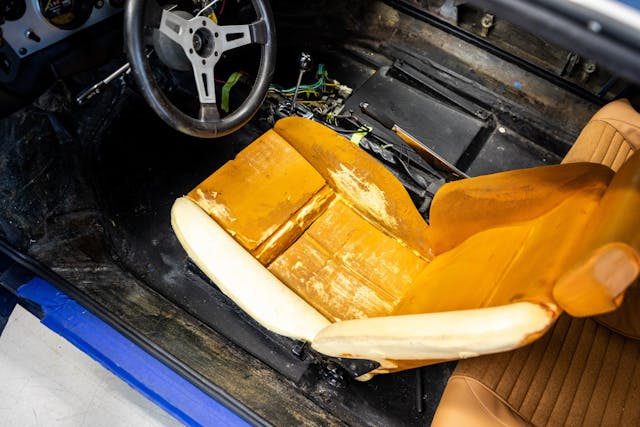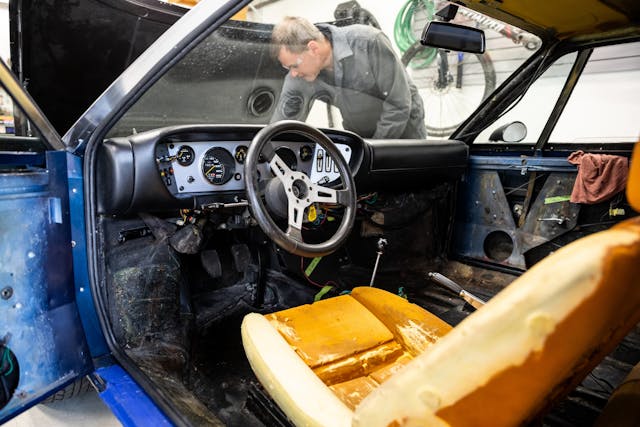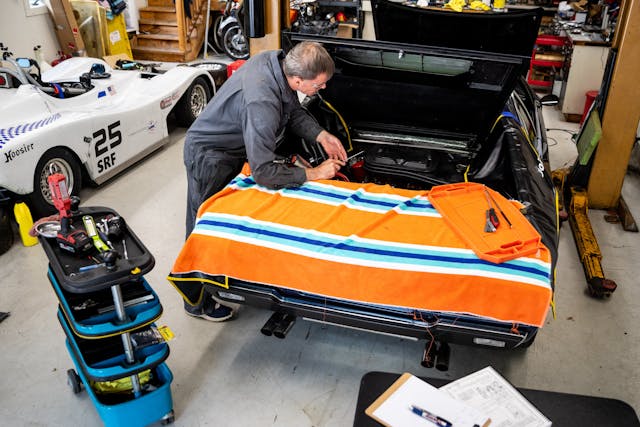$25K Project Dino: The Setback Machine
This story first appeared in the September/October 2024 issue of Hagerty Drivers Club magazine. Join the club to receive our award-winning magazine and enjoy insider access to automotive events, discounts, roadside assistance, and more.
In the six months since the last update on my eternal Dino 308 GT4 restoration project (“The Curse of the Dino”), I’ve had sunny days of optimism and long, dark nights of despair. May 6, 2024, was one of those nights, rock bottom in my 3.5-year quest to get this $25,000 Ferrari back on the road.
You might recall the myriad challenges, such as the engine that had to be rebuilt not once, but twice, and the untimely deaths of two craftsmen—an exterior painter and an interior trim specialist—who both happened to pass away while working on my project. By this spring, those sad episodes were behind me, the Dino ran well, and its new blue paint job shone brightly. All I had to do was put the car back together and send it off to a new trim man for interior work. Easy Street ahead.
Except I was missing the steering column switch assembly and its three stalks that control the lights, turn signals, and wipers. In April 2023, I had it shipped to a gentleman in Boston who had developed a unique method for repairing old, brittle plastics. By January, I started calling him weekly. Whenever I managed to get him on the phone, he assured me that, despite his health issues, he’d have my switches done “in a day or two.”

These perfectly pleasant but fruitless conversations went on for much of the winter, and I started wondering if I’d ever see the switches again. A new assembly doesn’t quite look right and costs four grand, but it would suffice. Problem was, along with the switches, I’d also sent the hood they attach to. At the very least, I needed that hood, which covers the steering shaft and is engraved with the car’s serial number. My suggestion that he send the hood back while he continued working on the switches fell on deaf ears.
How long could I go on pestering this man, a senior citizen who serves a small yet passionate slice of the automotive community, about my little switches? At some point, humanity trumps car lust, right? I pondered flying to Boston, showing up at his house, paying him for his time, and returning with my parts. Then I remembered that Hagerty columnist Rob Siegel, aka the Hack Mechanic, lives in the Boston area. Could he go knock on the door?
Siegel did so one day in April, but no one was home. On a second visit, Siegel made contact, but he got the same “in a day or two” I’d heard for months. One week later, however, the rebuilt switches and hood arrived. The bill was about $1000.
I installed the switches and dropped the Dino at a local shop for new tires and a suspension alignment. On May 6, I planned to drive it home from the shop. It would be my first time behind the wheel with all the refreshed mechanical subsystems installed and ready to run. It would be a celebration. I’m almost done!
Instead, new problems slapped me across the face. Issue one: The engine barely ran. It sputtered, popped, and backfired like a cantankerous toddler. I was lucky to limp the Dino home. Issue two: The new switches worked only intermittently. Great.
For two days, I didn’t lay eyes on the car. I cursed myself for taking on this white elephant. I had been so cocky, so confident, back in January 2021, when I bought the thing. The challenge was the point, I happily told anyone who would listen. What a fool. I’d grown to hate this misery-inducing Italian. The time had come to call the pros.
If it takes a village to raise a child, it takes a small city to bring a Ferrari back on the road.
My local mechanic couldn’t see the car for two weeks. In the meantime, he told me to get some rubber gloves and hold each spark plug a half-inch from the engine. A properly operating plug should throw an arc over that gap. I disconnected the fuel pump and had my son crank the engine as I held each plug. The plug on cylinder five produced a spark that easily crossed the gap. A plug from the V-8’s other cylinder bank only sparked when I touched it to the engine. That spark was meek by comparison and hard to see. Aha!

Luckily, the Ferrari engine has two complete ignition systems, one for each bank of four cylinders. Two ignition coils supply the electrical energy and two distributors guide that energy to the right plug at the right time. That made it relatively easy to swap parts until I located the culprit: a quarter-sized metal cylinder called a condenser. Once I replaced that, the engine purred, and I drove the car 20 miles to a neighboring town and back. Did that feel good? Damn right it did.
Newly confident, I removed the switches and found a bad ground. Another problem emerged: The fuel-pump fuse would intermittently pop. A friend and I spent half a day tracing that to a tiny torn wire buried in the wiring harness. We were proud of ourselves.


The tables had decidedly turned and I began to love the Dino again. I finished putting the car back together and sent it off for the interior work. I’m sure I’ll encounter plenty of teething problems, but with every passing mechanical success, I feel less anxious about fixing them.
If it takes a village to raise a child, then it takes a small city to bring a Ferrari back on the road. I cherish these projects for the people I meet and the things I learn along the way. My love-it-and-hate-it Dino has been a fountain of uncommon experiences, and I hope you’re enjoying hearing about them.









Thank you all for reading! And the positive words.
I know how you feel. I am almost done a simple generic 2000 Mustang GT. I am not a mechanic so I have to pay for the work. I would have been better to buy a 2024 GT or a higher output Mustang. I got $45K in the car and it still needs wheels and paint. But the sound this stroker makes is magic. People know this is not a stock machine even though it looks like a daily driver from 24 years ago.
I can understand your frustration–especially with that sudden poorly running engine. Lucky for you at least four of your cylinders continued to operate. I experienced the same intermittent ignition problem with my 73 BMW, until it finally quit completely, fortunately in my garage. I never knew a dead condenser = dead ignition = dead car.
I’ve been messing with good ole Kettering-style ignition (coil, points, condenser) since 1963, and this was my first experience with total condenser failure. Ten minutes and my ’02 was back among the living. Even an old dog can learn new tricks. A spare condenser has now joined the points, cap, rotor and spark plugs in my on-board spares kit.
Larry – thank you for the story and for bravely restoring a really cool car!
i’m sorry i bought a Ferrari!
Bought an 84 308 for $20,000 with bad ignition 5 years ago. Got an Electromotive kit from Nick Forza. Been running very well.
I’m retired now. Back in the day I taught auto shop when it was called that. When I thought about buying a used Ferrari project, noted prancing horse guru Mike Sheehan wrote in R&T there is nothing more expensive, time consuming or frustrating than a cheap Ferrari! I’m paraphrasing him, of course.
That you fell for the same Dino model which also caught my eye,made me smile! In your story you were going where I thought I might once go with a similar Ferrari project! You have not disappointed in sharing your elation as well as your crushing disappointment.
As a reader and wrench turner I have felt your emotional swings. How could I not? Realizing an engine has to come out before tools, hands and fingers can fit into certain spaces always makes for one of those palm to forehead moments mere words can’t convey!
There’s certainly joy to be found in such projects. The advice of guru’s too, goes only so far! We each must live and learn for ourselves even if it can be unpleasant at times! Eventually the finish line comes. Even when you wonder if it was all worth it, I hope you will enjoy the drive!
Keep up the good fight Larry. While vintage Ferrari ownership can be a soul-crushingly debilitating affair – as you’ve well documented – when it comes to the cost of certain parts and finding competent techs to perform the tasks too difficult for mere mortals, it’s still just a collection of metal, plastic, glass, and rubber bits; like any old car.
Case in point: this time around you solved a couple of problems that could have beset any old car just as easily as your Ferrari. It’s the momentum from those little wins that help get us over the larger hurdles still to come….and then on to the finish line.
You have a wonderful old Ferrari; one of fewer than 3,000 built. Ever. At some point in its life, every car – if it’s driven that is – will need exactly the same work done to it.
But 99% of those won’t be a vintage Ferrari.
Enjoy your car….and the drive.